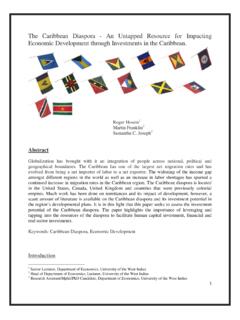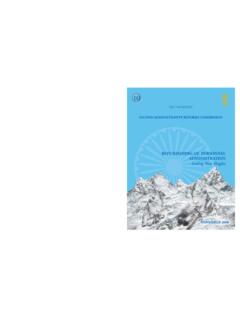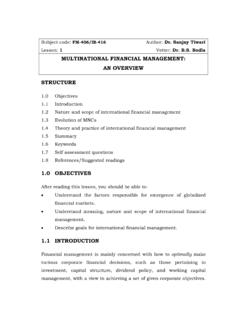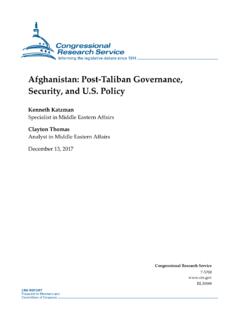Transcription of CHAPTER - IV HISTORY OF TOURISM IN INDIA
1 1. CHAPTER - IV. HISTORY OF TOURISM IN INDIA . TOURISM in the early period The HISTORY of TOURISM developed mainly through indirect sources in the early period. In INDIA , in the early days of agricultural abundance, export of cash crops created an important trade link. Manufacture of iron-ore into steel for weaponry was another important item of trade by the later Vedic period. Tools and textiles were other renowned Indian products. Contemporary Greek and Hebrew scholars have noted the wonder of INDIA and her fabled wealth. Owing to the predominance of trade routes over . land crossing between Asia and Europe, trade tours were an important development in this period. In the early days, pilgrimage or pilgrim travel assumed great importance. Ashoka the great, travelled a great deal in his eagerness to spread the doctrines of Buddha. Throughout his travels, from Pataliputra to Lumbini on to Kapilavastu and Sarnath and finally to Gaya, Emperor Ashoka had special memorials set up at each spot and also rest houses where travellers could rest.
2 Trees were planted along the road sides so that the traveller would be protected from the harsh sun shine. Harsha was another great emperor who gently influenced by the Buddhist scriptures, built institutions and Dharamsalas for the travellers. Rest houses were built in towns and villages. A number of monasteries were also built for the pilgrims. This shows that travel facilities were much improved and travel was not a cumbersome experience. 2. Brahmin villages evolved into centres of learning attracting scholars. At this time the Buddhist Sanga established the tradition of pilgrimage, when monks went from village to village and court preaching the value of the middle-path. Rest houses were provided for the travellers. Monastries also attracted the monks, middlemen and laymen. The Arthashastra reflects the protection given to merchants and their high status in the Indian society.
3 Insurance and safe passage for goods, regulation of prices, weights and measures and the use of gold, silver and copper as rates of exchange also indicate a well developed mode of trade and travel. Some of the first foreigners to visit INDIA , were perhaps the Persians. There is much evidence of caravans of Persians visiting INDIA , in the inscriptions dating to the rein of the Persians King Darius. There is also reference to trade, commerce and cultural exchanges between Persia and INDIA . During the rein of Chandragupta Maurya, Persian customs have been practiced in the courts. Hieun-tsang, a devout Chinese Buddhist journeyed to INDIA in 633 AD, his journey to INDIA was hard and perilous. His mission was to collect and translate ancient Buddhist scriptures. Several expeditions crossed from Greece via Persia or Mesopotamia to INDIA . Greek accounts reveal that in INDIA , chariot roads were well laid out and horses, elephants and camels were a common mode of transport.
4 Trees for shade, wells, rest houses and security were also well organised. One of the most important developments of this era owing to the emergence of trade and commerce, was the emergence of communication and accommodation. When Alexander the Great reached INDIA , it is said that he found good roads which were well maintained covered with shady trees. Marco Polo was another great traveller who in the 13th century passed 3. through INDIA on his way back from China. All travellers were much interested in seeing INDIA and her fabled riches for themselves. This proves that INDIA was a rich and prosperous country in those days. In the works of Mark Twain, he had aptly put it as, ** Of splendour and rags There is only one INDIA .. The one land that all men desire to see and having seen once by even a glimpse .. will not give that glimpse for the shows of the rest of the world put together.
5 The Arthashastra also reveals the importance of the travel infrastructure for the state, classification of routes and types of vehicles. This is an indication that there was a well developed mode of travel in INDIA for the military, the commercial traveller and the civilian. Travel on inland waterways was also under state protection and regulation. In cities, bazaars provided access to goods brought from the hinterland. Travellers were accommodated in overnight places of stay, known as serais at the city gates where all services were provided to them. State regulations insisted on travellers carrying with them a note for safe passage from one territory to the other. Entertainment and dancing halls were allowed, gambling was licensed and was a source of income for the state. Travelling for pleasure on the rivers and to the hills was a tradition started by the royal courts.
6 However such movement attracted all those who had business at the court to move with it from the heat and dust of the cities to the calm and serenity of the retreat. During the rule of the Mughals, the emperors travelled extensively and contributed towards resort development. Even today the remains of the past like the mile stones, sarais and a network of roads and paths that make all corners of this vast country accessible. 4. With the fall of the great empires , there was a set back in trade and commerce. This reduced the mobility of the people with the exception of pilgrims. The sea side resorts hill stations and spas which were the centres of recreation and pleasure were hardly ever used by the early medieval period. Over the years, however the scenario changed and a complex character of TOURISM emerged. The growth of modern technology, rising incomes and improved facilities contributed to the emergence of modern TOURISM .
7 5. TOURISM in the modern period The Rail network in INDIA placed the needs for recreation within the reach of an increasingly large number of people who had leisure time and the means to enjoy it. Air INDIA came into existence with the enactment of Air Corporations Act on 1st August 1963, when the entire air transport industry in INDIA was nationalised. At the time of nationalisation, Air INDIA operated four weekly flights on the INDIA /UK route and three flights fort-nightly on the INDIA /Nairobi route. Today, it has an extended network of air routes linking all the five continents of the globe. Air INDIA organises special programmes to give a wide publicity for projecting INDIA . Soon, Indian Airlines began, with a view to establishing an air transport network to link the remotest places in INDIA . Today, Indian Airlines has expanded its wings to nearby countries as well.
8 They have introduced many schemes and offers like the Discover INDIA package, *. Leave Travel Concessions encouraged domestic TOURISM . Concessions for the youth and students also promoted travel within the country. In the early 1960's The ITDC ( INDIA TOURISM Development Corporation). was started to provide western comforts to International visitors. The ITDC. played a major role as a catalyst in developing a modern superstructure (eg, The Ashoka group of hotels) for International tourists. The government set up infrastructure to promote TOURISM by establishing Air INDIA and TOURISM promotion offices in London and Frankfurt. The TOURISM cell in the Ministry of Aviation was upgraded into a department. The private sector was invited to establish luxury facilities for the high spending tourist. The first pioneer in this field was Mohan Singh Oberoi, who began his career in the hotel business with the Clarks Hotel in Shimla and the Grand Hotel in Calcutta.
9 6. THE PROGRESS OF TOURISM IN INDIA . (Development through successive five year plans). Although INDIA had a good amount of TOURISM activity when it became independent over 50 years ago, TOURISM as a subject did not figure in the Constitution of INDIA , except that some of its components were mentioned in the central or state lists. There was also no allocation for TOURISM development during the First Five Year Plan. However, during the Second Five Year Plan (1956-61) TOURISM became a constituent of the Planning process with a token allocation of crores for both Central and State sectors put together. The development approach during the second plan was mainly on creating isolated facilities in important tourist centres. The Third Plan witnessed the beginning of an era for the development of activities connected with TOURISM , particularly adventure TOURISM , by the establishment of a winter sports complex at Gulmarg in Kashmir.
10 The INDIA TOURISM Development Corporation (ITDC) was set up in 1966 to develop TOURISM infrastructure and promote INDIA as a tourist destination. The approach during the Fourth and Fifth Plan was expansion and improvement of tourist facilities with a view to promote Destination traffic'. as distinct from transit traffic. Integrated development of selected tourist centres like Kovalam, Gulmarg, Goa, Kullu-Manali etc., received much attention and became the symbolic models of resort TOURISM in INDIA Cultural TOURISM was emphasised with development of Buddhist Centres and heritage monuments in INDIA through master plans. 7. The Sixth Plan (1980-85) was a major landmark in the HISTORY of Indian TOURISM . The first ever TOURISM Policy' of the country was announced during 1982 which specified the development objectives and provided an action plan based on Travel Circuit' concept to maximise the benefits of TOURISM .





